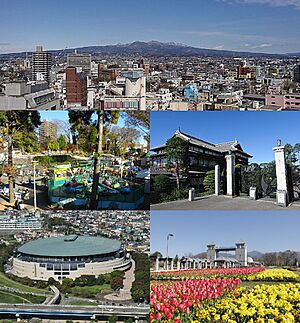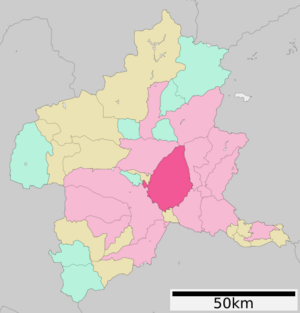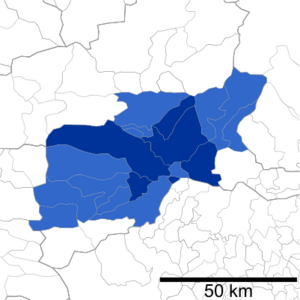Maebashi facts for kids
Quick facts for kids
Maebashi
前橋市
|
|||
|---|---|---|---|
 |
|||
|
|||

Location of Maebashi in Gunma Prefecture
|
|||
| Country | |||
| Region | Kantō | ||
| Prefecture | Gunma | ||
| First official record | 4th century AD | ||
| City settled | April 1, 1892 | ||
| Area | |||
| • Core city | 311.59 km2 (120.31 sq mi) | ||
| Population
(August 31, 2020)
|
|||
| • Core city | 335,352 | ||
| • Density | 1,076.260/km2 (2,787.50/sq mi) | ||
| • Metro
(2015)
|
1,263,034 (12th) | ||
| Time zone | UTC+9 (Japan Standard Time) | ||
| - Tree | Ginkgo & Zelkova | ||
| - Flower | Rose & Azalea | ||
| Phone number | 027-224-1111 | ||
| Address | 2-12-1, Ote-Machi, Maebashi-shi, Gunma-ken 371-8601 | ||
Maebashi (pronounced Mah-eh-bah-shee) is a cool city in Japan. It's the capital of Gunma Prefecture, located in the northern Kantō region. As of August 2020, about 335,352 people live there. The city covers an area of 311.59 square kilometers. Maebashi used to be the biggest city in Gunma Prefecture. However, Takasaki grew larger after merging with nearby towns. Maebashi is often called the "City of Water, Greenery, and Poets." This is because it has clean water, lots of nature, and was home to famous Japanese poets like Sakutarō Hagiwara.
Contents
- What's in a Name? The Story of Maebashi
- Maebashi's Journey Through Time
- Where is Maebashi? Geography and Surroundings
- Maebashi's Weather: Climate and Seasons
- How Many People Live in Maebashi?
- Maebashi's Economy
- Learning in Maebashi: Schools and Universities
- Getting Around: Transportation in Maebashi
- Sports in Maebashi
- Fun Things to See and Do in Maebashi
- Famous People from Maebashi
- Maebashi's Sister Cities
- See also
What's in a Name? The Story of Maebashi
The area where Maebashi is located was once called Umayabashi. This name comes from a bridge over the Tone River. Near the bridge, there was a small rest stop with a stable. Travelers on the Tōzan-dō road, which connected the capital to eastern Japan, often used this stop.
In 1649, during the Edo period, the name was officially changed to Maebashi. This happened when Maebashi became a castle town. It was also the center of the Maebashi Domain, a local ruling area under the Tokugawa shogunate.
Maebashi's Journey Through Time
Maebashi became a town on April 1, 1889. This was when Japan created its modern system of towns and cities. Just three years later, on April 1, 1892, Maebashi officially became a city.
World War II and Rebuilding
During World War II, on August 5, 1945, a large part of Maebashi was destroyed. About 64.2% of the city's center was hit by air raids. These attacks happened after people were warned by propaganda leaflets.
Growing the City: Mergers and Milestones
After the war, Maebashi began to grow.
- In 1951, part of Kaigaya Village joined Maebashi.
- On April 1, 1954, several more villages merged with the city. These included Kamikawabuchi, Shimokawabuchi, Azuma, Minamitachibana, Kaigaya, Haga, Motosōja, and Sōja.
- In 1957, a part of Jōnan village was added.
- On April 1, 1960, more parts of Tamamura Town and Jōnan village merged with Maebashi.
- Finally, in 1967, the rest of Jōnan village joined the city.
Maebashi hosted the 1999 IAAF World Indoor Championships in 1999. This was a big international sports event.
On April 1, 2001, Maebashi was named a special city. This gave it more power to make its own local decisions.
More towns and villages joined Maebashi in the 2000s:
- On December 5, 2004, the town of Ōgo and the villages of Kasukawa and Miyagi became part of Maebashi.
- On May 5, 2009, the village of Fujimi also merged with the city. After this, the Seta District no longer existed.
Maebashi became a core city on April 1, 2009. This is another important step that gives the city more local control.
Where is Maebashi? Geography and Surroundings
Maebashi is located at the base of Mount Akagi. It's in the northeast part of the Kantō Plain. The city is also surrounded by Mount Haruna and Mount Myōgi.
Two important rivers flow through Maebashi:
- The Tone River, which is the second-longest river in Japan.
- The Hirose River.
Even though Maebashi is over 100 kilometers away from the coast, the southern part of the city is only about 100 meters above sea level. The highest point in Maebashi is 1823 meters high. This is on the south side of Mt. Kurohino, a peak of Mount Akagi. Maebashi is actually the Japanese prefectural capital that is farthest from the sea, about 120 km away.
The cities around Maebashi form a large urban area with over a million people. Farmland separates this area from the bigger Greater Tokyo region.
Neighboring Towns and Cities
Maebashi shares borders with several other places in Gunma Prefecture:
Maebashi's Weather: Climate and Seasons
Maebashi has a humid subtropical climate. This means it has hot, humid summers and mild winters.
Winter Winds
In winter, a dry wind called karakkaze blows from the north. This happens because snow clouds from the Sea of Japan are blocked by the Echigo Mountain Range. Because of this, Maebashi has dry winters. It's also one of the sunniest places in Japan, with over 2,210 hours of sunshine each year.
Summer Heat
Summers in Maebashi are hot because the city is inland. However, it's usually not as hot as coastal Tokyo. On July 24, 2001, Maebashi reached a temperature of 40 degrees Celsius (104 degrees Fahrenheit). This was one of the hottest temperatures ever recorded in Japan.
| Climate data for Maebashi (1991−2020 normals, extremes 1896−present) | |||||||||||||
|---|---|---|---|---|---|---|---|---|---|---|---|---|---|
| Month | Jan | Feb | Mar | Apr | May | Jun | Jul | Aug | Sep | Oct | Nov | Dec | Year |
| Record high °C (°F) | 22.0 (71.6) |
24.6 (76.3) |
27.1 (80.8) |
32.4 (90.3) |
36.5 (97.7) |
39.4 (102.9) |
40.0 (104.0) |
39.8 (103.6) |
38.1 (100.6) |
33.0 (91.4) |
27.3 (81.1) |
25.2 (77.4) |
40.0 (104.0) |
| Mean daily maximum °C (°F) | 9.1 (48.4) |
10.0 (50.0) |
13.5 (56.3) |
19.3 (66.7) |
24.2 (75.6) |
26.8 (80.2) |
30.5 (86.9) |
31.7 (89.1) |
27.3 (81.1) |
21.7 (71.1) |
16.4 (61.5) |
11.5 (52.7) |
20.2 (68.4) |
| Daily mean °C (°F) | 3.7 (38.7) |
4.5 (40.1) |
7.9 (46.2) |
13.4 (56.1) |
18.6 (65.5) |
22.1 (71.8) |
25.8 (78.4) |
26.8 (80.2) |
22.9 (73.2) |
17.1 (62.8) |
11.2 (52.2) |
6.1 (43.0) |
15.0 (59.0) |
| Mean daily minimum °C (°F) | −0.5 (31.1) |
0.0 (32.0) |
3.1 (37.6) |
8.2 (46.8) |
13.6 (56.5) |
18.0 (64.4) |
22.0 (71.6) |
23.0 (73.4) |
19.3 (66.7) |
13.2 (55.8) |
6.9 (44.4) |
1.9 (35.4) |
10.7 (51.3) |
| Record low °C (°F) | −11.8 (10.8) |
−9.0 (15.8) |
−7.8 (18.0) |
−3.1 (26.4) |
0.3 (32.5) |
6.0 (42.8) |
11.9 (53.4) |
13.6 (56.5) |
8.4 (47.1) |
0.6 (33.1) |
−3.5 (25.7) |
−7.4 (18.7) |
−11.8 (10.8) |
| Average precipitation mm (inches) | 29.7 (1.17) |
26.5 (1.04) |
58.3 (2.30) |
74.8 (2.94) |
99.4 (3.91) |
147.8 (5.82) |
202.1 (7.96) |
195.6 (7.70) |
204.3 (8.04) |
142.2 (5.60) |
43.0 (1.69) |
23.8 (0.94) |
1,247.4 (49.11) |
| Average snowfall cm (inches) | 8 (3.1) |
9 (3.5) |
2 (0.8) |
0 (0) |
0 (0) |
0 (0) |
0 (0) |
0 (0) |
0 (0) |
0 (0) |
0 (0) |
1 (0.4) |
19 (7.5) |
| Average precipitation days (≥ 0.5 mm) | 3.5 | 4.4 | 8.3 | 9.0 | 10.6 | 14.5 | 16.6 | 14.0 | 13.4 | 9.9 | 6.1 | 3.8 | 114.2 |
| Average relative humidity (%) | 54 | 52 | 52 | 55 | 60 | 70 | 73 | 72 | 72 | 68 | 62 | 57 | 62 |
| Mean monthly sunshine hours | 213.1 | 201.2 | 211.0 | 205.2 | 197.4 | 138.5 | 146.3 | 167.7 | 134.9 | 155.6 | 181.0 | 202.0 | 2,153.7 |
| Source: Japan Meteorological Agency | |||||||||||||
How Many People Live in Maebashi?
| Historical population | ||
|---|---|---|
| Year | Pop. | ±% |
| 1920 | 51,015 | — |
| 1930 | 53,052 | +4.0% |
| 1940 | 52,898 | −0.3% |
| 1950 | 68,710 | +29.9% |
| 1960 | 240,301 | +249.7% |
| 1970 | 273,864 | +14.0% |
| 1980 | 311,121 | +13.6% |
| 1990 | 335,704 | +7.9% |
| 2000 | 341,738 | +1.8% |
| 2010 | 340,390 | −0.4% |
| 2020 | 332,149 | −2.4% |
Maebashi's population grew a lot for a long time. Recently, the number of people living in the city has stayed about the same.
Maebashi's Economy
In 2010, the larger Maebashi area had a total economic output of about 59.8 billion US dollars. Some important companies have factories in Maebashi. These include Sanden Corporation, which makes air conditioning systems and compressors. Also, Sagamiya Foods, a company that makes tofu products, has manufacturing sites here. The Gunma Bank also has its main office in Maebashi.
Learning in Maebashi: Schools and Universities
Maebashi has many schools for students of all ages.
Universities and Colleges
There are several universities and colleges in Maebashi:
- Gunma Prefectural College of Health Sciences
- Gunma University
- Gunma University of Health and Welfare
- Maebashi Institute of Technology
- Maebashi Kyoai Gakuen College
Elementary and High Schools
The city government runs 54 public elementary schools and 21 public middle schools. There are also two private elementary and two private middle schools. For high school, Gunma Prefecture operates nine public high schools, and the city government runs one. Maebashi also has five private high schools and one private school that combines middle and high school.
There is also an international school:
- Gunma Korean Elementary and Junior High School (群馬朝鮮初中級学校) – This is a school for North Korean students.
Getting Around: Transportation in Maebashi
Maebashi has a good transportation system, including trains and highways.
Train Lines
 JR East – Jōetsu Line
JR East – Jōetsu Line
- Shin-Maebashi - Gumma-Sōja
 JR East – Ryōmō Line
JR East – Ryōmō Line
- Komagata - Maebashi-Ōshima - Maebashi - Shin-Maebashi
- Jōmō Electric Railway Company – Jōmō Line
- Chūō-Maebashi - Jōtō - Mitsumata - Katakai - Kamiizumi - Akasaka - Shinzō-Kekkan Center - Egi - Ōgo - Higoshi - Kitahara - Araya - Kasukawa - Zen
Major Highways
 Kan-etsu Expressway – Maebashi Interchange
Kan-etsu Expressway – Maebashi Interchange Kita-Kantō Expressway – Maebashi-Minami Interchange
Kita-Kantō Expressway – Maebashi-Minami Interchange National Route 17
National Route 17 National Route 50
National Route 50 National Route 291
National Route 291 National Route 353
National Route 353
Sports in Maebashi
The soccer team Thespakusatsu Gunma plays at Shoda Shoyu Stadium Gunma in Maebashi. The team was first formed in Kusatsu, but they play in Maebashi to meet the stadium rules for the J.League.
Fun Things to See and Do in Maebashi
Maebashi has many interesting places to visit and fun events.
Local Attractions
- Gunma Prefectural Government Building
- Kōzuke Kokubun-ji ruins – These are the remains of an old temple and are a National Historic Site.
- Maebashi Castle – The site of an old castle.
- Maebashi Tōshō-gū – A shrine.
- Shikishima Park
Festivals
- Ogo Gion Festival – A lively local festival.
Famous People from Maebashi
Many talented people come from Maebashi, including:
- Tōru Furusawa, a voice actor.
- Great-O-Khan, a professional wrestler.
- Sakutarō Hagiwara, a famous poet.
- Gran Hamada, a professional wrestler.
- Hajime Hosogai, a professional football player.
- Shigesato Itoi, a game designer and writer.
- Nobuyuki Kojima, a professional soccer player.
- Nigo, a fashion designer and DJ.
- Kamiizumi Nobutsuna, a master of martial arts.
- Kōhei Oguri, a film director.
- Tetsuya Ota, a race car driver.
- Sho Sakurai, a singer, actor, and newscaster.
- Genichiro Sata, a politician.
- Takashi Shimizu, a film director known for the Ju-On movies.
- Atsuko Tanaka, a voice actress.
- Yutaka Yoshie, a professional wrestler.
Maebashi's Sister Cities
Maebashi has special connections with other cities around the world. These are called sister cities.
 Birmingham, United States
Birmingham, United States
Maebashi also has friendly relationships with Menasha, United States, and Orvieto, Italy.
See also
 In Spanish: Maebashi para niños
In Spanish: Maebashi para niños






